from Faraday Copper Corp. (isin : CA2176212009)
Faraday Copper Intersects 20.07 m at 1.20% Copper within 100.29 m at 0.42% Copper in the American Eagle Area
VANCOUVER, BC / ACCESSWIRE / June 25, 2024 / Faraday Copper Corp. ("Faraday" or the "Company") (TSX:FDY)(OTCQX:CPPKF) is pleased to announce the results of nine drill holes from its ongoing Phase III drill program at the Copper Creek Project, located in Arizona, U.S. ("Copper Creek"). Two holes were drilled to test near-surface mineralization potential in the American Eagle area and five reconnaissance holes were drilled to test previously undrilled breccias near Area 51 outside of the recent Starship and Eclipse breccia discoveries. Two holes were drilled in the Bald area between Area 51 and American Eagle.
Paul Harbidge, President and CEO, commented "The first two drill holes that Faraday has completed at the American Eagle area, which is situated above the underground resource, have confirmed our thesis that there is significant near-surface mineralization present. This area offers the potential for a substantial increase in open pit resources that could enhance the scale of the project. Current drilling is ongoing in the American Eagle area, where we continue to target near-surface mineralization with the vision of a new high tonnage open pit resource being defined."
Highlights
- At the American Eagle area, two holes were drilled to test the potential for a new open pit mineral resource to be defined above the current American Eagle underground resource.
- Intersected 20.07 metres ("m") at 1.20% copper, 0.0997% molybdenum and 6.8 grams per tonne ("g/t") silver from 406.58 m in drill hole FCD-24-064 (~230 m below surface). This intercept is within 100.29 m at 0.42% copper, 0.0223% molybdenum and 1.84 g/t silver from 395.41 m. This drill hole ended in mineralization.
- Intersected 22.92 m at 0.58% copper from 227.34 m in drill hole FCD-24-065. This intercept is within 142.69 m at 0.31% copper from 219.26 m (less than 150 m below surface). The results from this hole represent the discovery of significant copper mineralization at the previously undrilled SK-3 and Prada breccias.
- Reconnaissance drilling at Area 51 confirmed prospectivity at depth. Several recently mapped breccias near Area 51 intercepted short intervals of copper mineralization and elevated silver. Geochemical and mineralogical data suggests the drilling intersected the upper portion of a potentially mineralized system. Follow-up drilling is planned to test the potential at depth.
- Exploration upside with many untested breccias and porphyries that have been emplaced along the principal controlling fault structures in the district. As targets are tested and either advanced or removed from the exploration plan, a continuous pipeline of targets for drill testing is being developed.
(For true width information see Table 1.)
The American Eagle area has dimensions of approximately 800 m by 1,000 m and is a host to numerous prospective breccias and porphyries that have been mapped at surface and have a strong copper geochemical signature. These surface expressions locate above the large underground porphyry resource, which is approximately 500 m to 1,100 m depth below surface. The near-surface mineralization was not adequately tested historically as previous drilling was vertical to steeply inclined. Mapped geology, isolated historical drill intercepts and historic small scale mining highlight the potential for near-surface mineralization. Approximately 54,000 metric tonnes at 3.78% copper were historically extracted from a series of narrow stopes to 90 m depth at the American Eagle breccia (Higgins, 1911) 1. The first two drill holes Faraday has completed in this area have confirmed the potential for significant near-surface mineralization, with mineralized intercepts in the two drill holes approximately 190 m apart laterally. Drilling continues in this area.
- Drill hole FCD-24-064 was collared south of the SK-3 breccia and drilled to the north. It intersected granodiorite and several hydrothermal breccias as well as zones of high-density early halo veins. Breccia intervals occur from 46 m to 159 m, from 183 m to 201 m, from 347 m to 362 m, and from 407 m to 422 m. Shallow breccia intercepts are pyrite cemented but below 183 m downhole, chalcopyrite is significant and increases with depth. The vertical sulphide zonation highlights the potential for copper mineralization below the pyrite cemented breccias. Besides chalcopyrite and pyrite in breccia cement, mineralization also occurs in vein zones; molybdenite is abundant from 407 m to 422 m. The drill hole ends in mineralization hosted in veinlets. Sericite is the dominant alteration mineral in breccias whereas sericite and kaolinite are associated with vein zones hosted in granodiorite.
- Drill hole FCD-24-065 was collared south of the SK-3 breccia and drilled to the northwest. The hole intersected igneous cemented breccia from surface to 52 m and quartz-pyrite and tourmaline cemented breccia with short intervals of granodiorite from 52 m to 304 m. Chalcopyrite appears together with pyrite around 140 m depth downhole and increases downward. The hole ends in mineralization hosted in granodiorite cross-cut by veinlets. Sericite-kaolinite is the dominant alteration affecting the breccia domains and the granodiorite at the end of the hole.
Area 51 was identified as highly prospective by integrating airborne versatile time domain electromagnetic (VTEM) geophysical data and short wave infrared spectral data together with geological mapping and sampling. Area 51 encompasses a porphyry intrusion with nine mapped breccia bodies over an area of approximately 400 m by 400 m, including the Starship and Eclipse discoveries (announced on January 16, 2024 and March 4, 2024). The breccias are interpreted to have been emplaced at a shallow crustal level in the hanging wall of the northwest trending Holy Joe thrust fault, which brought Proterozoic metamorphic rocks in contact with younger sedimentary rock units to the east of Area 51. East to northeast striking extensional faults have down dropped Area 51, which is manifested by the preservation of shallow features such as Glory Hole volcanic host-rocks, epithermal alteration assemblages and pyrite together with specular hematite as breccia cement. Three reconnaissance holes were drilled into breccias outside the known mineralization. To date, 13 holes have been drilled into this area, testing six breccias, and confirmed that two breccias contain significant mineralization starting at surface. An additional two breccias show prospectivity at depth. Data is currently being interpreted and modeled for follow up drilling.
- Drill hole FCD-24-057 was collared near the Starship breccia and drilled to the north-northeast. It started in granodiorite and intersected breccia from approximately 31 m to 42 m and approximately 59 m to 93 m. Breccia intervals are variably cemented by quartz, pyrite, specular hematite and tourmaline. From 93 m to 141 m, the hole intersected Glory Hole volcanics and entered basement rocks (Pinal Schist) below that depth. Dominant alteration is sericitic throughout the hole.
- Drill hole FCD-24-058 was collared near the Starship breccia and drilled to the northwest. The hole started in granodiorite, which includes igneous cemented breccia domains from 24 m to 100 m. Pyrite-cemented breccia is present from 100 m to 121 m and the remainder of the hole intersected Glory Hole volcanics. The dominant alteration is sericite and kaolinite to 121 m, after which alteration intensity decreases.
- Drill hole FCD-24-061 was collared north of the Nebula breccia and drilled to the southeast. The hole intersected Glory Hole volcanics for the first 149 m, except for a short interval of breccia from 21 m to 25 m. From 149 m to 219 m, it entered quartz-pyrite cemented breccia and short intervals of granodiorite porphyry. The hole ended in Proterozoic quartzite. Alteration in and adjacent to the breccia is sericitic with some kaolinite and localized occurrence of dickite and pyrophyllite. The breccia intervals have some samples exceeding 0.3% copper and up to 1.34 g/t silver over 16.39 m, suggesting mineralization potential at depth.
The Titan breccia was identified through geological mapping, along with several other previously unidentified breccias, in an area approximately 400 m northwest of Area 51. The Titan breccia extends over 100 m in an east-west direction. Two reconnaissance holes were drilled into this breccia and suggest copper mineralization at depth, warranting follow up drilling.
- Drill hole FCD-24-059 was collared south of the Titan breccia and drilled to the north-northeast. The hole started in Glory Hole volcanics and entered quartz-pyrite cemented breccia from 15 m to 45 m. From 45 m to 91 m, the dominant lithology is Glory Hole volcanics crosscut by two granodiorite dykes. From 91 m to 137 m, the hole intersected variably pyrite-specular hematite-tourmaline and quartz cemented breccia, followed by Glory Hole volcanics. Granodiorite was intersected from 171 m to the end of the hole at 176.91 m. Alteration associated with breccia intervals is sericite-kaolinite. Chalcopyrite is locally present as breccia cement resulting in 2.16 m at 0.27% copper and 1.93 g/t silver from 112.87 m.
- Drill Hole FCD-24-060 was collared at the same location as FCD-24-059 but drilled to the northwest. The hole intercepted hydrothermal breccia from Surface to 111 m with variable amounts of pyrite, specular hematite, tourmaline and quartz cement. From 111 m to 131 m, the hole intersected Glory Hole volcanics and entered granodiorite thereafter. Alteration associated with the breccia is sericite and chlorite.
Bald is an area approximately 230 m south of the SK-3 breccia and includes breccias and porphyries exposed at surface. Two holes were drilled to test for shallow mineralization.
- Drill Hole FCD-24-062 was collared at Bald and drilled to the northeast. The hole starts in Glory Hole volcanics and a short intercept of hydrothermal breccia, followed by granodiorite porphyry from 15 m to 27 m. Sulphides in this zone are oxidized. Pyrite and quartz cemented breccia is the dominant lithology from 27 m to 91 m, after which granodiorite was intersected. Modest chalcopyrite occurs from 27 m to 60 m. Alteration associated with breccia is sericite-tourmaline.
- Drill Hole FCD-24-063 was collared south of Bald and drilled to the northeast. The first 108 m intersected porphyry and igneous cemented breccia which locally hosts elevated silver grades. From 108 m to 140 m, pyrite, tourmaline, specular hematite and quartz cemented breccia is present. Alteration associated with the hydrothermal breccia is sericitic. Below 140 m granodiorite is dominant. The granodiorite is cross-cut by veins containing pyrite and lesser chalcopyrite.
Next Steps
Phase III drilling continues and is focused on three objectives:
- Reconnaissance and follow-up drilling on new targets;
- Expanding the MRE; and
- Better delineating high-grade mineralized zones.
The current focus of drilling is on near-surface mineralization in the American Eagle area. Drill holes FCD-24-064 and FCD-24-065, reported herein, have demonstrated the potential for an open pit resource to be defined.
As part of the Phase III program, 32 drill holes have been completed and results for 28 have been released. Thirteen holes were drilled in Area 51, three in the Copper Prince-Copper Giant area, eleven in the Bald-American Eagle area, three near Old Reliable and two in the Titan breccia.
Figure 1: Plan View Showing Surface Geology and Location of Drill Holes
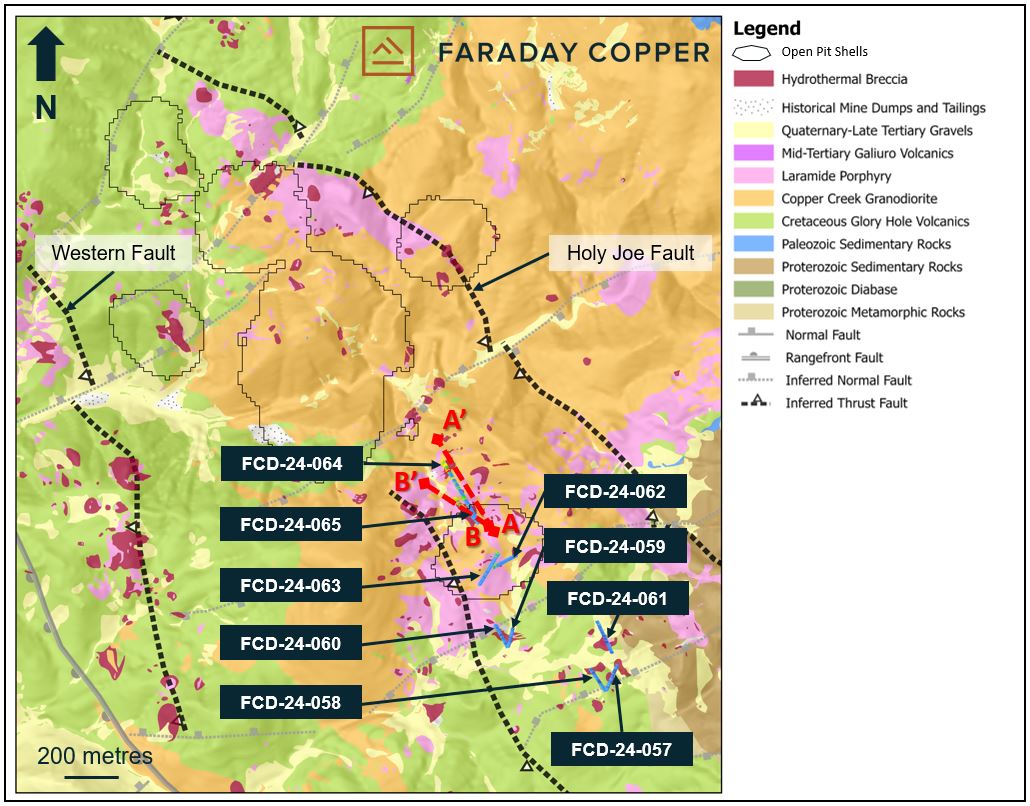
Note: The open pit shells are based on constraints used in the MRE as presented in the report titled "Copper Creek Project NI 43-101 Technical Report and Preliminary Economic Assessment" with an effective date of May 3, 2023 (the "Technical Report") available on the Company's website at www.faradaycopper.com and on the Company's SEDAR+ profile at www.sedarplus.ca.
Figure 2: Cross Section Showing Drill Hole FCD-24-064 at American Eagle
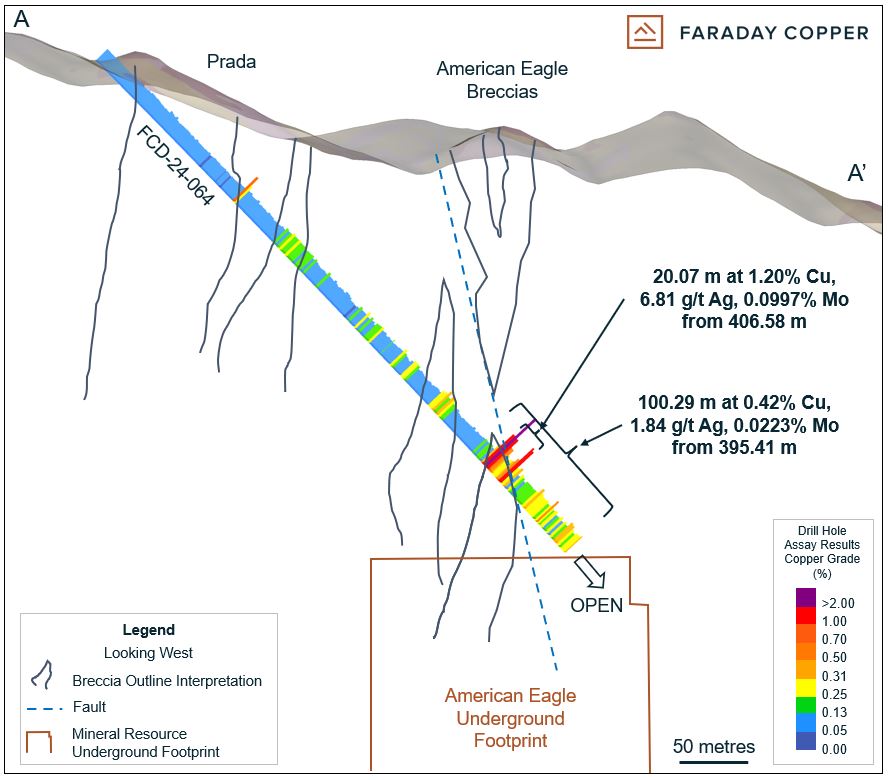
Note: The underground footprint is based on constraints used in the MRE as presented in the Technical Report available on the Company's website at www.faradaycopper.com and on the Company's SEDAR+ profile at www.sedarplus.ca.
Figure 3: Section showing drill hole FCD-24-065 and SK-3 breccia
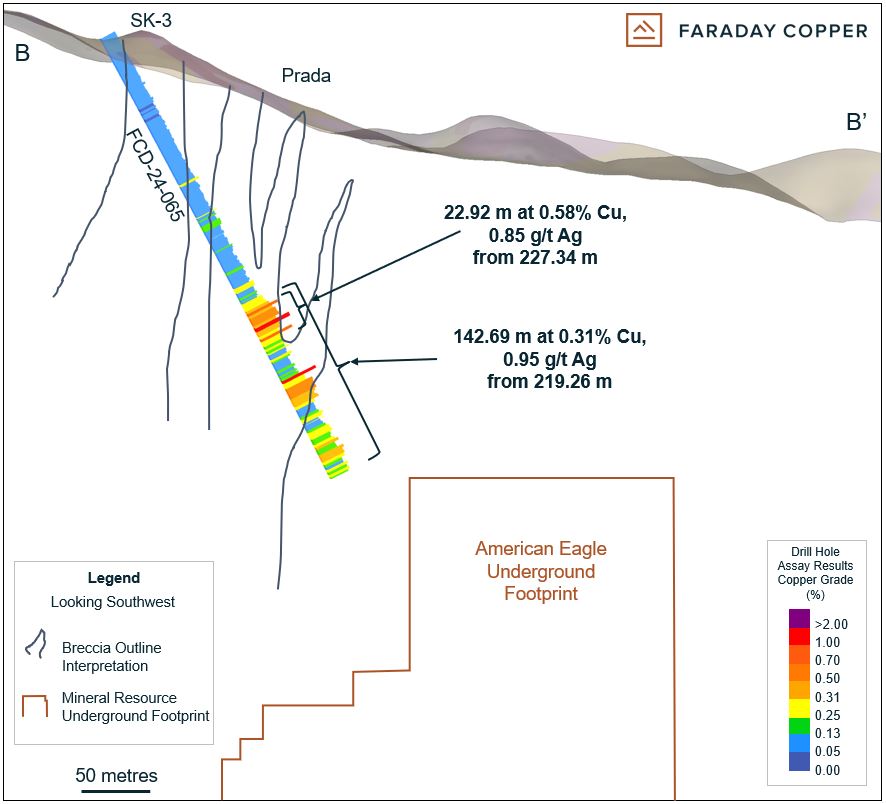
Note: The underground footprint is based on constraints used in the MRE as presented in the Technical Report available on the Company's website at www.faradaycopper.com and on the Company's SEDAR+ profile at www.sedarplus.ca.
Figure 4: Isometric View Showing Drill Holes FCD-24-064 and FCD-24-065 at the American Eagle Area
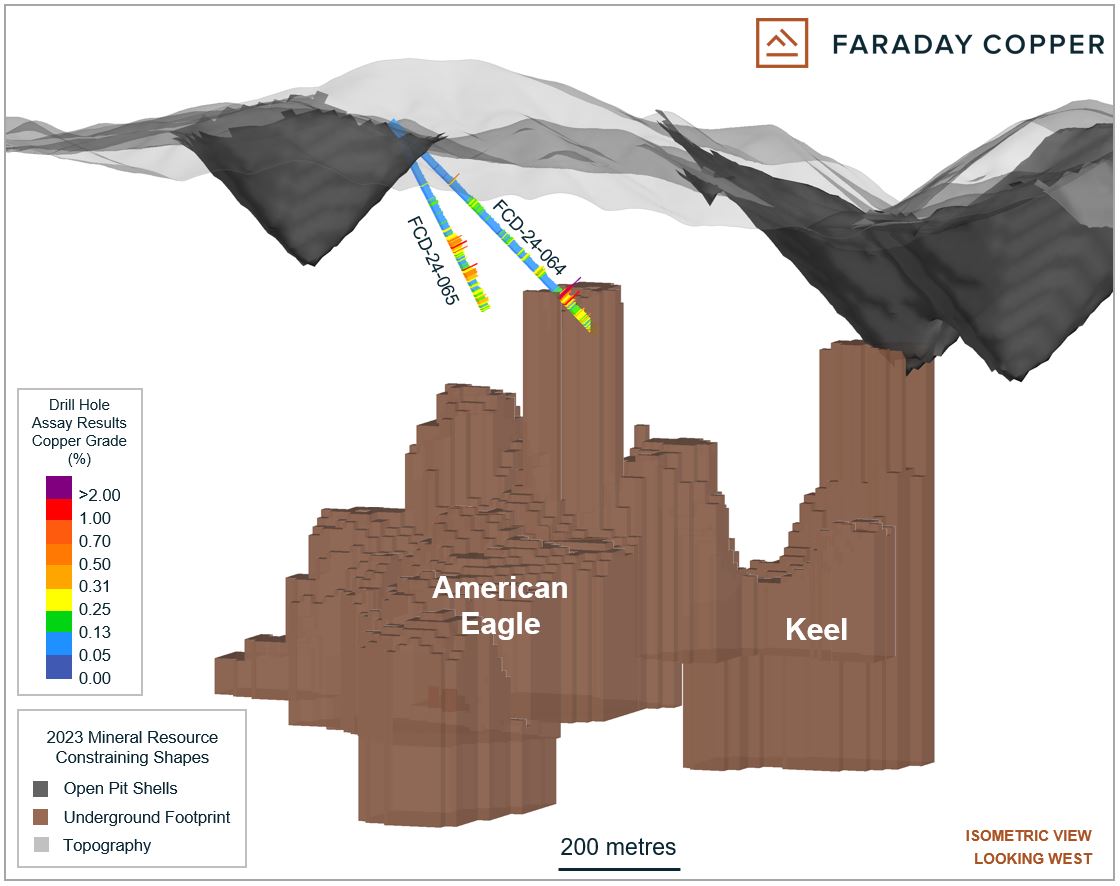
Note: The open pit shells and underground footprint are based on constraints used in the MRE as presented in the Technical Report available on the Company's website at www.faradaycopper.com and on the Company's SEDAR+ profile at www.sedarplus.ca.
Figure 5: A core sample from drill hole FCD-24-064 (approximately 409 m to 411 m)
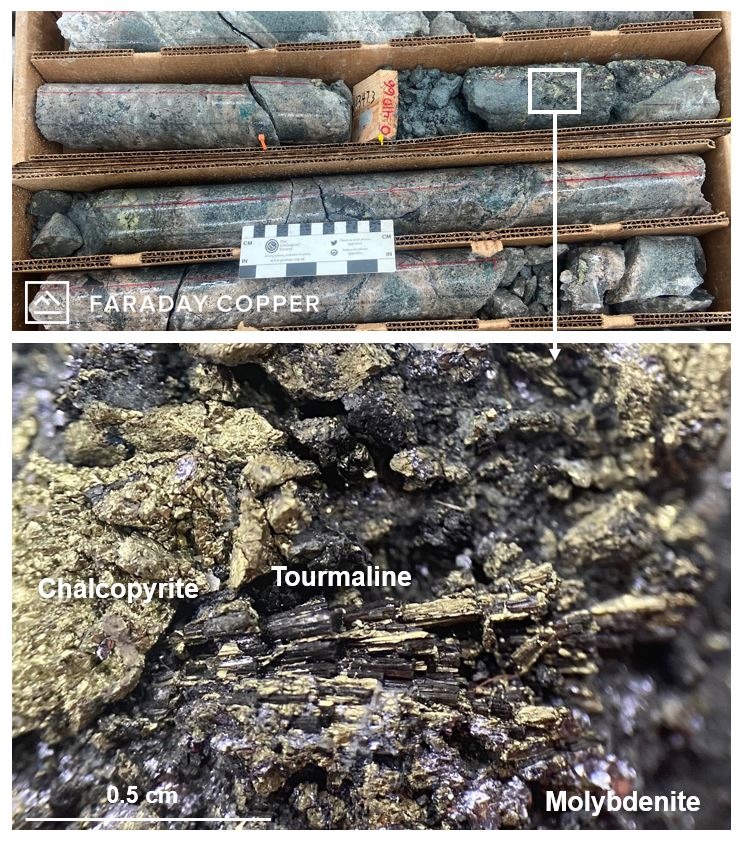
Table 1: Selected Drill Results from Copper Creek
| Drill Hole ID | From | To | Length | True Width | Cu | Au | Ag | Mo |
(m) | (m) | (m) | (m) | (%) | (g/t) | (g/t) | (%) | |
| FCD-24-064 | 184.80 | 217.20 | 32.4 | 28 | 0.15 | N/A | 0.57 | 0.0005 |
| and | 348.66 | 364.27 | 15.61 | 14 | 0.25 | N/A | 0.90 | 0.0006 |
| and | 395.41 | 495.70 | 100.29 | 87 | 0.42 | 0.02 | 1.84 | 0.0223 |
| including | 406.58 | 426.65 | 20.07 | 17 | 1.20 | 0.07 | 6.81 | 0.0997 |
| FCD-24-065 | 148.22 | 160.18 | 11.96 | 11 | 0.13 | 0.01 | 0.41 | 0.0002 |
| and | 219.26 | 361.95 | 142.69 | 124 | 0.31 | 0.01 | 0.95 | 0.0058 |
| including | 227.34 | 250.26 | 22.92 | 20 | 0.58 | 0.01 | 0.85 | 0.0015 |
| and including | 282.38 | 303.52 | 21.14 | 18 | 0.51 | 0.02 | 1.83 | 0.0004 |
| FCD-24-062 | 0.00 | 43.03 | 43.03 | 43 | 0.13 | N/A | 0.62 | 0.0004 |
| FCD-24-063 | 304.30 | 316.53 | 12.23 | 12 | 0.17 | N/A | 0.54 | 0.0008 |
| FCD-24-061 | 9.02 | 25.41 | 16.39 | 16 | 0.05 | N/A | 1.34 | 0.0002 |
| FCD-24-057 | No significant intercepts | |||||||
| FCD-24-058 | No significant intercepts | |||||||
| FCD-24-059 | No significant intercepts | |||||||
| FCD-24-060 | No significant intercepts | |||||||
Note: All intercepts are reported as downhole drill widths. Mineralization includes bulk porphyry style and breccia mineralization true widths are approximate due to the irregular shape of mineralized domains. N/A: Not analyzed.
Table 2: Collar Locations from the Drill Holes Reported Herein
| Drill Hole ID | Easting | Northing | Elevation | Azimuth | Dip | Target | Depth | Depth |
(m) | (°) | (°) | (ft) | (m) | ||||
| FCD-24-064 | 549157 | 3623132 | 1353 | 330 | 45 | American Eagle | 1510.9 | 495.70 |
| FCD-24-065 | 549157 | 3623132 | 1353 | 316 | 62 | SK-3 Breccia | 1103.2 | 361.95 |
| FCD-24-062 | 549219 | 3622924 | 1358 | 060 | 58 | Bald | 741.4 | 243.23 |
| FCD-24-063 | 549157 | 3622842 | 1357 | 030 | 57 | Bald | 982.9 | 322.48 |
| FCD-24-061 | 549701 | 3622677 | 1355 | 155 | 45 | Nebula Breccia | 749.1 | 245.76 |
| FCD-24-057 | 549750 | 3622353 | 1386 | 023 | 45 | Area 51 | 585.3 | 192.02 |
| FCD-24-058 | 549747 | 3622350 | 1386 | 328 | 45 | Area 51 | 594.2 | 194.95 |
| FCD-24-059 | 549291 | 3622554 | 1304 | 016 | 55 | Titan Breccia | 539.2 | 176.91 |
| FCD-24-060 | 549290 |

